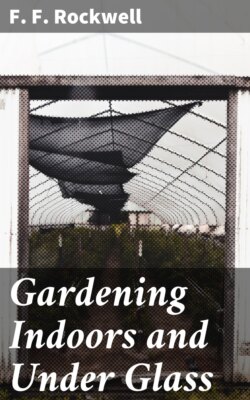Читать книгу Gardening Indoors and Under Glass - F. F. Rockwell - Страница 23
На сайте Литреса книга снята с продажи.
TRANSPLANTING, POTTING AND REPOTTING
ОглавлениеDirections have already been given for preparing the best soil for house plants. This soil, sifted through a coarse screen—say a one-half inch mesh—is just right for "pricking off" or transplanting the little seedlings.
Use flats similar to those prepared for the seeds, but an inch deeper. In the bottom put an inch of the rough material screened from sods and manure. Give this a thorough watering; cover with an inch of the sifted soil, and wet this down also. Then fill the box nearly level full of the sifted soil, which should be neither dry nor moist enough to be sticky. Take care also that this soil is not much—if any—colder than the temperature in which the seedlings have been kept.
It is usually best to transplant the seedlings just as soon as they are large enough to be handled, which is as soon as the second true leaf appears. Nothing is gained by leaving them in the seed boxes longer, as they soon begin to crowd and get lanky and are more likely to be attacked by the damping off fungus than they are after being transferred.
Find a table or bench of the right height upon which to work comfortably. With a flat stick, or with a transplanting fork (which can be had for fifteen cents) lift a bunch of the little plants out, dirt and all, clear to the bottom of the box. Hold this clump in one hand and with the other gently tear away the seedlings, one at a time, discarding all crooked or weak ones. Never attempt to pull the seedlings from the soil in the flat, as the little rootlets are very easily broken off. They should come away almost intact, as shown facing page 48. Water the seed flats the day previous to transplanting, so that the soil will be in just the right condition, neither wet enough to make the roots sticky, nor so dry as to crumble away.
Take the little seedling by the stem between the thumb and forefinger, and with a small round pointed stick or dibber, or with the forefinger of the other hand, make a hole deep enough to receive the roots and about half the length—more if the seedlings are lanky—of the stem. As the little plant is dropped into place, the tips of both thumbs and forefingers, by one quick, firm movement, compress the earth firmly both down on the roots and against the stem so that the plant sticks upright and may not readily be pulled out. Of course there is a knack about it which cannot be put into words—I could have pricked off a hundred seedlings in the time I am spending in trying to describe the operation—but a little practice will make one reasonably efficient at it.
When the flat is completed, jar it slightly to level the surface and give a watering, being careful, however, to bend down the plants as little as possible. Set the plants on a level surface, and if the sun is bright, shade with newspapers during the middle of the day for two or three days.
From now on until ready for potting, keep at the required temperature, as near as possible, and water thoroughly on bright mornings when necessary, but only when the drying of the surface shows that the soil needs it. Above all, give all the air possible, while maintaining the necessary heat. The quality of the mature plants will depend more upon this precaution than upon anything else in the way of care.
The little seedlings are sometimes put from the seed flat directly into small pots. I strongly advise the method described above. The flats save room and care, and the plants do much better for a few weeks than they will in pots. Where room is scarce, it is well to transplant cuttings into flats instead of potting them off. As soon, however, as either the transplanted plants or cuttings begin to crowd in the flats, they must be put into pots. How soon this will be depends largely, of course, upon the amount of room they have been given. As many as a hundred are often set in a flat 13x19 inches, but it is well to give them twice as much space as that if room permits.
